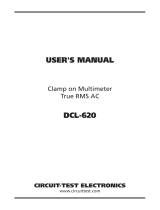
DC CURRENT MEASUREMENT
Do not measure 20A currents for longer than 30 seconds. Exceeding 30
seconds may cause damage to the meter and/or test leads.
1) Insert the black test lead banana plug into the negative COM jack.
• For current measurements up to 4000μA DC, set the function switch to
the μA position and insert the red test lead banana plug into the μA
jack.
• For current measurements up to 400mA DC, set the function switch to
the mA position and insert the red test lead banana plug into the mA
jack.
• For current measurements up to 10A DC, set the function switch to the
10A position and insert the red test lead banana plug into the 10A jack.
2) Press the MODE button to show “DC” on the screen.
3) Remove power from the circuit under test, then open up the circuit at
the point where you wish to measure current.
4) Touch the black test probe tip to the negative side of the circuit.
5) Touch the red test probe tip to the positive side of the circuit.
6) Apply power to the circuit.
7) Read the current displayed on the screen.
AC CURRENT MEASUREMENT
Do not measure 20A currents for longer than 30 seconds. Exceeding 30
seconds may cause damage to the meter and/or test leads.
1) Insert the black test lead banana plug into the negative COM jack.
• For current measurements up to 10A, set the function switch to the 10A
position and insert the red test lead banana plug into the 10A jack.
• For current measurements up to 400mA, set the function switch to the
mA position and insert the red test lead banana plug into the mA jack.
• For current measurements up to 4000µA, set the function switch to the
µA position and insert the red test lead banana plug into the µA jack.
2) Press the MODE button to indicate “AC” on the screen.
3) Remove power from the circuit under test, then open up the circuit at
the point where you wish to measure current.
4) Touch the black test probe tip to the negative side of the circuit. Touch
the red test probe tip to the positive side of the circuit.
5) Apply power to the circuit.
6) Read the current displayed on the screen.
9


















